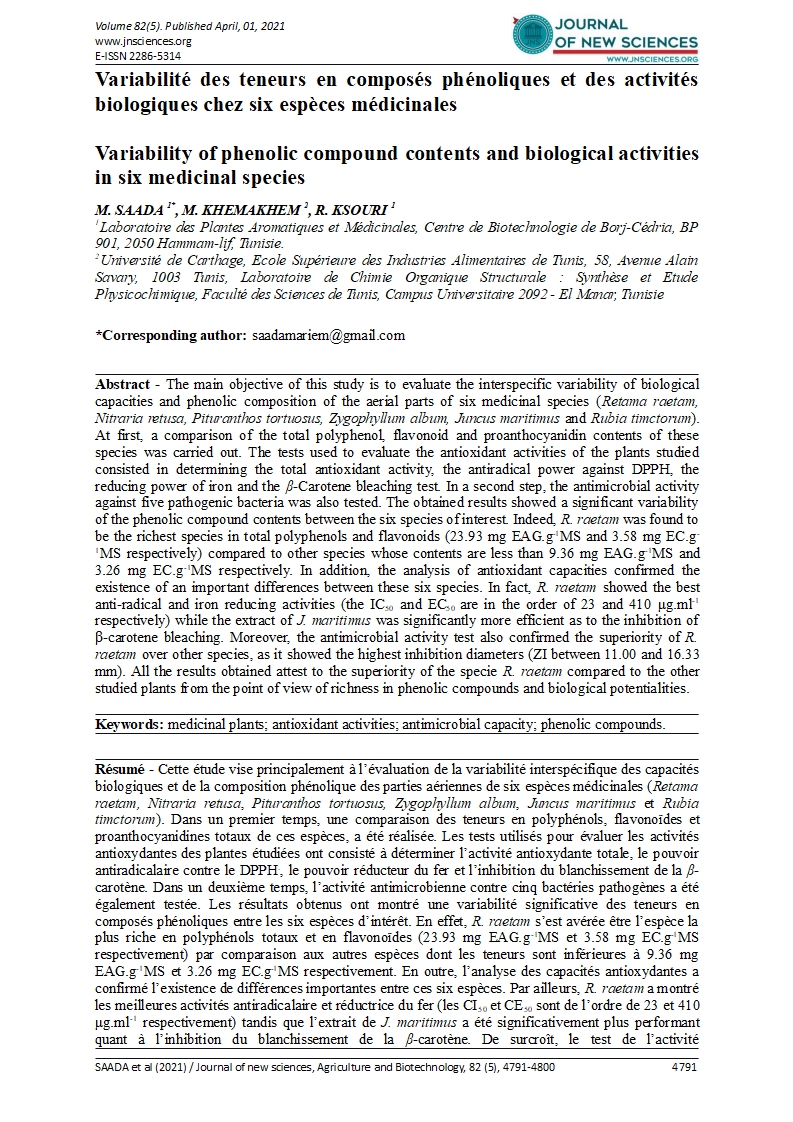

- Category: Volume 82
- Hits: 2680
Variability of phenolic compound contents and biological activities in six medicinal species
Variabilité des teneurs en composés phénoliques et des activités biologiques chez six espèces médicinales
M. SAADA 1
M. KHEMAKHEM 2
R. KSOURI 1
1Laboratoire des Plantes Aromatiques et Médicinales, Centre de Biotechnologie de Borj-Cédria, BP 901, 2050 Hammam-lif, Tunisie.
2Université de Carthage, Ecole Supérieure des Industries Alimentaires de Tunis, 58, Avenue Alain Savary, 1003 Tunis, Laboratoire de Chimie Organique Structurale : Synthèse et Etude Physicochimique, Faculté des Sciences de Tunis, Campus Universitaire 2092 - El Manar, Tunisie
Abstract - The main objective of this study is to evaluate the interspecific variability of biological capacities and phenolic composition of the aerial parts of six medicinal species (Retama raetam, Nitraria retusa, Pituranthos tortuosus, Zygophyllum album, Juncus maritimus and Rubia timctorum). At first, a comparison of the total polyphenol, flavonoid and proanthocyanidin contents of these species was carried out. The tests used to evaluate the antioxidant activities of the plants studied consisted in determining the total antioxidant activity, the antiradical power against DPPH, the reducing power of iron and the β-Carotene bleaching test. In a second step, the antimicrobial activity against five pathogenic bacteria was also tested. The obtained results showed a significant variability of the phenolic compound contents between the six species of interest. Indeed, R. raetam was found to be the richest species in total polyphenols and flavonoids (23.93 mg EAG.g-1MS and 3.58 mg EC.g-1MS respectively) compared to other species whose contents are less than 9.36 mg EAG.g-1MS and 3.26 mg EC.g-1MS respectively. In addition, the analysis of antioxidant capacities confirmed the existence of an important differences between these six species. In fact, R. raetam showed the best anti-radical and iron reducing activities (the IC50 and EC50 are in the order of 23 and 410 μg.ml-1 respectively) while the extract of J. maritimus was significantly more efficient as to the inhibition of β-carotene bleaching. Moreover, the antimicrobial activity test also confirmed the superiority of R. raetam over other species, as it showed the highest inhibition diameters (ZI between 11.00 and 16.33 mm). All the results obtained attest to the superiority of the specie R. raetam compared to the other studied plants from the point of view of richness in phenolic compounds and biological potentialities.
Keywords: medicinal plants; antioxidant activities; antimicrobial capacity; phenolic compounds.
Résumé - Cette étude vise principalement à l’évaluation de la variabilité interspécifique des capacités biologiques et de la composition phénolique des parties aériennes de six espèces médicinales (Retama raetam, Nitraria retusa, Pituranthos tortuosus, Zygophyllum album, Juncus maritimus et Rubia timctorum). Dans un premier temps, une comparaison des teneurs en polyphénols, flavonoïdes et proanthocyanidines totaux de ces espèces, a été réalisée. Les tests utilisés pour évaluer les activités antioxydantes des plantes étudiées ont consisté à déterminer l’activité antioxydante totale, le pouvoir antiradicalaire contre le DPPH., le pouvoir réducteur du fer et l’inhibition du blanchissement de la β-carotène. Dans un deuxième temps, l’activité antimicrobienne contre cinq bactéries pathogènes a été également testée. Les résultats obtenus ont montré une variabilité significative des teneurs en composés phénoliques entre les six espèces d’intérêt. En effet, R. raetam s’est avérée être l’espèce la plus riche en polyphénols totaux et en flavonoïdes (23.93 mg EAG.g-1MS et 3.58 mg EC.g-1MS respectivement) par comparaison aux autres espèces dont les teneurs sont inférieures à 9.36 mg EAG.g-1MS et 3.26 mg EC.g-1MS respectivement. En outre, l’analyse des capacités antioxydantes a confirmé l’existence de différences importantes entre ces six espèces. Par ailleurs, R. raetam a montré les meilleures activités antiradicalaire et réductrice du fer (les CI50 et CE50 sont de l’ordre de 23 et 410 μg.ml-1 respectivement) tandis que l’extrait de J. maritimus a été significativement plus performant quant à l’inhibition du blanchissement de la β-carotène. De surcroît, le test de l’activité antimicrobienne a confirmé également la supériorité de R. raetam par rapport aux autres espèces, étant donné qu’elle a montré les diamètres d’inhibition les plus élevés (ZI entre 11.00 et 16.33 mm). L’ensemble des résultats obtenus atteste de la supériorité de l’espèce R. raetam comparé aux autres plantes étudiées de point de vue richesse en composés phénoliques et potentialités biologiques.
Mots clés : plantes médicinales ; activités antioxydantes ; capacité antimicrobienne ; composés phénoliques.

